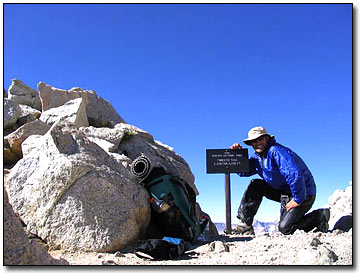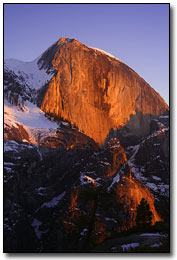|
Backpacking lightweight is not a new concept. Since the advent of what we consider
backcountry hiking, there have been those who have headed into the backcountry with
little more to accompany them than a blanket and a little food. Indeed, anyone who
has hiked for an extended period of time knows the value of lightening the weight
one carries.

A lighter backpack can not only help propel one up that hill, or help
ones knees on the backside of that hill, but also can help to enjoy the overall
venture even more. Before I began my lightweight change, I would hike just to get
there. Now - with less weight - I can actually hike just to hike.
As I look back several years ago, my backpack must have weighed in at over 50lbs. It
was an all too familiar feeling for me, hike a few minutes, rest. Hike a few minutes,
rest. With my heart beating so hard and my head reeling in exhaustion, I had a hard
time enjoying what should have been solitude and serenity, but was only downright
punishment. By noon, it was time to rest for the day due to simple exhaustion. In
fact, it had gotten to the point of me disliking many of my trips (even though I
pushed myself to do it again).
It was during one of these moments several years ago when the ray of light in the
form of an ultralight PCT hiker dawned over the next hill. I knew it could be done.
So I set out to learn all I could learn about the philosophy and methods behind
lightweight backpacking. Over the last several years, I have come to appreciate the
benefits of having a lighter pack. I am no where near as exhausted as before, I can
actually look up and around when hiking, and the whole wilderness experience is
profoundly different.
Ultimately, the philosophy and methods boils down to several steps to lighten up
that pack. The goal of these steps is to lighten up the backpack without a loss to
comfort or safety. IMHO most of the descriptions below do just this: but I leave it
to the better judgement of the reader to decide.
Step 1:
Lighten the BIG three: tent, sleeping bag, and backpack. These three items usually
rank in the top three heaviest items one carries into the backcountry. Cutting down
on these items can save pounds!
TENTS: Many lightweight tents are out on the market nowadays. These include superb
tents manufactured by Stephenson and Hilleberg, just to name a few. Although many of
these tents vary in weight and price, the lightest 3 season shelter that can be
 found is also the simplest: a tarp. With the advent of extremely light silicone
impregnated nylon, these tarps weigh in at less than a pound, are cheap, and are
easy to make. Tarps are sold by multiple manufacturers; including Integral Designs,
Golite, and the increasingly popular tarptent (aka Henry Shires). When I first used
a tarp I was quite impressed. The tarp not only kept me and everything beneath it
bone dry, but with the openness of the shelter, I felt a better connection to the
world around me. The tarp survived a 30 minute Sierra hailstorm, and also survived
howling winds upwards of 40 mph. In addition, the openness facilitated ventilation -
condensation can be quite problematic in some tents to the point of having it rain
inside while the stars are shining outside. Although bugs can be problematic with
the open sides, a simple solution is to hang mosquito netting from the crest of the
tarp. This solution works exceptionally well even when the bugs are swarming outside
and adds only a few ounces.
found is also the simplest: a tarp. With the advent of extremely light silicone
impregnated nylon, these tarps weigh in at less than a pound, are cheap, and are
easy to make. Tarps are sold by multiple manufacturers; including Integral Designs,
Golite, and the increasingly popular tarptent (aka Henry Shires). When I first used
a tarp I was quite impressed. The tarp not only kept me and everything beneath it
bone dry, but with the openness of the shelter, I felt a better connection to the
world around me. The tarp survived a 30 minute Sierra hailstorm, and also survived
howling winds upwards of 40 mph. In addition, the openness facilitated ventilation -
condensation can be quite problematic in some tents to the point of having it rain
inside while the stars are shining outside. Although bugs can be problematic with
the open sides, a simple solution is to hang mosquito netting from the crest of the
tarp. This solution works exceptionally well even when the bugs are swarming outside
and adds only a few ounces.
SLEEPING BAGS: This is one of the items where cost is usually directly proportional
to weight and quality. Many manufacturers (such as Western Mountaineering and
Feathered Friends to name a few) produce bags which are rated at 20F and are below
2lbs. However, accompanying these advantages comes a hefty price: these bags
frequently exceed $300. A sleeping bag isn't always the only option however. Quilts
rank high in use by lightweight hikers, and can fair as well as sleeping bags - the
idea being that insulation below your body is crushed, thus reducing it's insulation
power.
BACKPACKS: Many backpacks are manufactured to withstand large and hefty loads - at
the price of its own weight. However, if weight and volume of the load is reduced
substantially, the frame and volume of the large pack become largely unnecessary.
Many backpacks are being manufactured by companies (such as Golite and
MountainSmith) which eliminate these heavy frames and thick fabrics, lightening up
the backpack from anywhere between 2-7 lbs! Yet, don't rush out to buy one of these
packs. In my opinion the pack should be the last item to change - after you know how
much volume and weight bearing capacity you may need.
Step 2:
Lighten up the smaller items: Many items within the backpack can easily be replaced
or eliminated, at no loss to comfort.
STOVE: With some exceptions, canister type stoves (like the MSR PocketRocket) tend
to be smaller and lighter than the liquid fuel type stoves (MSR Whisperlite). Yet
other options allow one to go even lighter. Alcohol stoves consume Denatured Alcohol
(which can be found in most hardware stores) and are typically made out of Pepsi
cans or cat food cans. These cans can be made at home with such simple tools as a
box cutter and file. In addition, the alcohol stove does not require a custom fuel
 canister to run - so fuel can be carried in a light plastic soda bottle. The
downfalls of the alcohol stove is that it takes longer to boil, is difficult to melt
snow, and no simple simmer option is available. Another option is to use solid fuel
tabs such as the Esbit Fuel Tabs. These are extremely light, yet have some
disadvantages such as smell (they tend to emit a foul odor), emissions (although
listed as non-toxic, they leave a black soot on the bottom of your pan), difficulty
to light - especially in windy conditions - and slow boiling times (including a lack
of simmering).
canister to run - so fuel can be carried in a light plastic soda bottle. The
downfalls of the alcohol stove is that it takes longer to boil, is difficult to melt
snow, and no simple simmer option is available. Another option is to use solid fuel
tabs such as the Esbit Fuel Tabs. These are extremely light, yet have some
disadvantages such as smell (they tend to emit a foul odor), emissions (although
listed as non-toxic, they leave a black soot on the bottom of your pan), difficulty
to light - especially in windy conditions - and slow boiling times (including a lack
of simmering).
POT: I have seen many people (I used to be one myself) carry multiple pots and pans,
including plates and silverware, into the backcountry. An easy way to lighten up is
to bring only the essentials: a single pot and a single spoon. The pot can be used
to cook in and can be eaten out of. This is easier done when out solo. However, with
a group of people it can get a little frustrating when everyone is reaching into the
same pot. When travelling in groups and this equipment is to be shared, good
communication prior to the trip about how dinner will be prepared is important.
SLEEPING MAT: This is a difficult issue for many, as comfort is quite dependent upon
the person. I am lucky enough to enjoy my closed cell foam mat. Yet there are some
who refuse to leave home without the air mattress. Understandably so. However,
unless your camping on snow the mattress does not have to be full length - legs
aren't essential to have a mattress under, and if one would like a little
cushion/insulation down there, unworn clothes and even an empty backpack work quite
well.
CLOTHES: Every day there seems to be another, lighter option popping onto the
market. So the choices are always there. Things to look for in lightweight clothing:
synthetic material (stay away from cotton), minimum amount of pockets and zippers,
thin fabric, and breathability.
SHOES:Although easier said than done, wearing tennis shoes or trail running shoes
can have an immense difference. Not only are they more breathable than hiking boots,
they are lighter and practically eliminate the need to bring along sandals (for
stream crossing or lounging in camp). In my experience, blisters form less in tennis
shoes, the shoes dry within a few hours (at most) after a full soaking (if it isn't
raining of course), they are more comfortable, and easier to remove to air out ones
feet. Caution must be heeded though: these shoes provide no ankle support,
increasing ones chance of injury if you have weak ankles or knees and/or a heavy
pack.
SEEK MULTIPURPOSE ITEMS: Many items you cart off into the backcountry can serve dual
purposes. For example, an empty backpack can serve as a ground mat for the upper or
lower body. Hiking poles can be used as tarp poles (and also fishing rods if one is
really ambitious). A bear canister as a stool or a wash basin. Extra clothes as a
pillow. The more items that can be used for 2 or more functions, the less items one
needs to carry.
Step 3:
Eliminate the Unnecessary: Unnecessary is a very relative term - where one person
might consider a book quite unnecessary, another might consider it precious as a
backcountry companion. The key here is to analyze what you carry, what you want, and
what you need.
Step 4:
Trim and Trim: I would consider this the last step, and the step where you know
you've really crossed the line into an obsession. Trimming means to cut up current
equipment, such as cutting the handle in half from your eating utensil and
toothbrush, cutting of brand name tags, removing un-necessary zippers or pockets,
etc. (An additional step to this is purchasing a scale where one can weight all of
the equipment, giving you a better sense of what to eliminate.)
Some Final Notes:
Lightening up can appear to be quite a daunting task, especially when questions of
equipment functionality arise. For example, will a tarp actually work in certain
conditions that one may face? Or how about a frameless backpack? One way to try and
overcome these obstacles is to bring along both the old and the new piece of
 equipment. For example, if you want to try out a tarp, bring it along with the tent
and set up both in camp. Sleep under the tarp to see if you like it. Test the tarp
out in stormy conditions. In my earlier (and even current) struggles to lighten up
my backpack, I have found the barrier for lightening up is more mental than anything
else - overcoming that barrier was essential to my progression.
It took me over two years to achieve the backpack weight that I now carry (which is
about 10lbs without food, water, and stove fuel plus some luxury items which all
vary tremendously upon the trip), signifying that lightening up is not an overnight
venture. It can take many trips and a lot of experience not only learn how to, but
also to be able to reduce packweight. The key is to lighten up safely, without
putting yourself or others at risk to certain backcountry dangers. Although some may
criticize that ultralight hikers are minimalist risk seekers (hopefully after
reading this you don't think so), I have found that nothing could be further from
the truth. I feel safer in the wilderness now than I ever did.
equipment. For example, if you want to try out a tarp, bring it along with the tent
and set up both in camp. Sleep under the tarp to see if you like it. Test the tarp
out in stormy conditions. In my earlier (and even current) struggles to lighten up
my backpack, I have found the barrier for lightening up is more mental than anything
else - overcoming that barrier was essential to my progression.
It took me over two years to achieve the backpack weight that I now carry (which is
about 10lbs without food, water, and stove fuel plus some luxury items which all
vary tremendously upon the trip), signifying that lightening up is not an overnight
venture. It can take many trips and a lot of experience not only learn how to, but
also to be able to reduce packweight. The key is to lighten up safely, without
putting yourself or others at risk to certain backcountry dangers. Although some may
criticize that ultralight hikers are minimalist risk seekers (hopefully after
reading this you don't think so), I have found that nothing could be further from
the truth. I feel safer in the wilderness now than I ever did.
|

